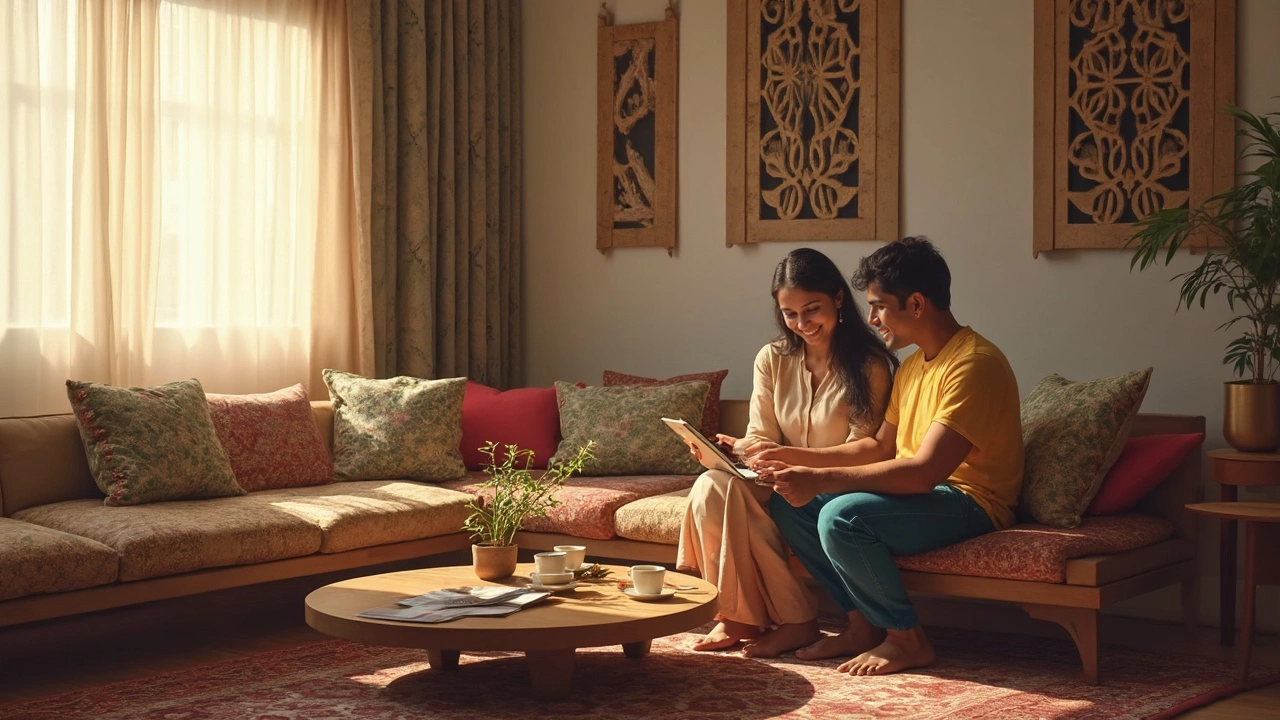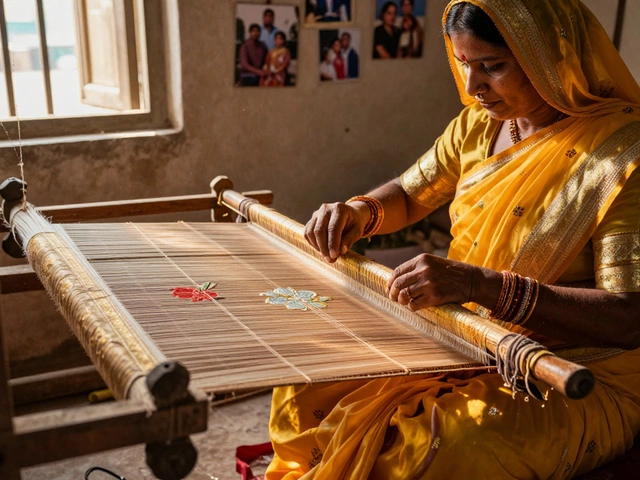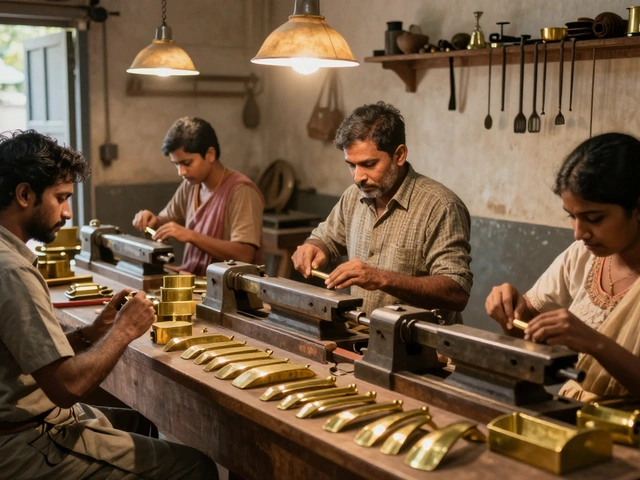Best Country to Buy Furniture: Why India Tops the List

Ever wondered where you should shop if you want killer furniture at amazing prices? Plenty of folks chase deals in Italy or Sweden, but India quietly leads the pack. I’ve seen friends spend serious cash on new sofas, only to realize later that just as good—or even better—quality was waiting halfway across the globe, for way less money.
Here’s the shocker: India isn’t just about budget buys. Indian manufacturers have cranked up their game, mixing old-school crafts with sharp factory efficiency. You’ll find solid wood, beautiful detail, and original styles—not mass-produced stuff that looks the same everywhere. And it’s not just about tradition. Modern studios in India are getting creative, blending Indian and international designs so you don’t feel stuck in a theme.
If you think buying furniture from India sounds complicated, stick around. There are easy ways to do it, and it often works out cheaper even with shipping. Plus, you get sturdy stuff built to last. I’m not saying every showroom is gold—like anywhere, you need to know what to look for. But if you like a little adventure with your shopping, and want your living room to stand out, India’s probably your best bet right now.
- What Makes a Country the Best for Furniture?
- India’s Furniture Manufacturing Boom
- Comparing India with Other Top Furniture Countries
- Tips for Buying Furniture from India
- Key Styles and Materials to Look For
- How to Avoid Common Pitfalls
What Makes a Country the Best for Furniture?
If you’re hunting for the best country for furniture, it’s not just about pretty showrooms. There’s a checklist that really matters—because nobody wants furniture that looks cool in photos but falls apart after a few months.
First up is quality. Top countries have skilled workers, good materials, and a reputation for solid, long-lasting stuff. Italy and Germany, for example, are famous for their craftsmanship—no shortcuts, just attention to every detail. Furniture manufacturers in India are right there too: they still do a lot of handwork, especially with wood and carving, so your pieces feel unique.
Then there’s the price. Some countries charge premium prices for their stellar pieces. But go to a place like India, and you often get amazing value. You’ll pay way less for solid wood than you would for pressed particleboard elsewhere. That’s a huge deal for buyers who want quality without the luxury sticker shock.
Another big factor is design variety. In countries that export a lot, you’ll see everything from classic to ultra-modern. India has a habit of mixing old-school charm—like hand-engraved teak—with trending styles, so there’s something for everyone, whether you want a traditional vibe or a minimalist space.
Let’s talk about sustainability. More buyers want eco-friendly furniture. The leading countries for furniture have shifted towards responsibly sourced wood and greener production. Indian manufacturers are increasingly certified for using plantation wood, recycled materials, or water-based finishes.
- Skilled workforce: Training, tradition, and experience matter. Top countries invest in people who know their craft.
- Quality materials: Access to good wood, sturdy fabrics, and reliable hardware is key. India’s native hardwoods (like mango and sheesham) are world-class.
- Cost-effectiveness: Weigh what you get for your money. India tends to win here hands down.
- Choice in design: More variety means you’ll actually find what you like.
- Export muscle: Countries like India ship furniture all over the world. That’s a sign people everywhere trust the stuff.
Here’s a quick look at how the big players compare when it comes to what buyers care about:
| Country | Main Strength | Price Range | Top Export Market |
|---|---|---|---|
| India | Handcrafted, affordable, strong | Low-Mid | USA, Europe |
| Italy | Luxury, design, tradition | High | Europe, USA |
| China | Speed, bulk production | Low-Mid | Global |
| Vietnam | Quality woodwork, value | Low-Mid | USA, Europe |
Put simply: The best country doesn’t just crank out pretty sofas. It delivers on quality, price, design, and trust. That’s why furniture manufacturers India are popping up on wish lists around the world.
India’s Furniture Manufacturing Boom
When people talk about countries famous for furniture, India sometimes gets overlooked. But here’s the truth—India is a global powerhouse for furniture manufacturers India. Over the past decade, India has exploded onto the scene with a mix of traditional skill and efficient production. You’ll find massive factories outside big cities like Jaipur, Moradabad, and Jodhpur. These places aren’t just making stuff for local markets; they’re shipping all over the world, from New York condos to hipster cafes in London.
What makes it work? India’s got a long legacy of woodworking, metalwork, and hand-carving skills passed down for generations. Artisans craft intricate designs, but companies have modernized the production side. Now, bulk orders and custom pieces can both get made at speed. Lots of buyers from the US and Europe tap Indian factories for this exact reason—they get high-quality, unique products and don’t have to wait months.
Check out some recent stats—India exported over $2 billion worth of furniture in 2023, and that number keeps climbing. It’s not just quantity, either. There’s a huge focus on solid wood furniture, especially teak, mango, and sheesham. You’ll also spot plenty of eco-friendly options, since more manufacturers use recycled materials and water-based finishes to keep things green.
| Year | Furniture Exports (USD) |
|---|---|
| 2021 | 1.5 Billion |
| 2022 | 1.8 Billion |
| 2023 | 2.1 Billion |
The boom goes beyond just numbers. Indian makers are killing it on the design front, too. They’re blending classic Indian patterns with clean, modern lines. So you get pieces that feel fresh, but with a cool story attached. If you care about quality furniture with a unique vibe, you can bet India’s manufacturing scene is hard to beat right now.
Comparing India with Other Top Furniture Countries
Shopping for furniture manufacturers India brings up the big question—how does India really stack up against powerhouses like Italy, China, and Sweden? It’s not just about price or style. Let’s break down what counts.
- Italy: Known for luxury and sleek design. If you like brands like Natuzzi or Poltrona Frau, you’re paying for the name, high-end materials, and insane attention to detail. But be ready: prices start high and go higher. It’s all about the designer label here.
- China: Mass production rules. Cheap deals and fast turnaround, but you have to watch quality. Some factories churn out great stuff, but you can also get products that won’t last through a move. Choices are endless, but customization is limited unless you buy in bulk.
- Sweden: Think IKEA. It’s stylish, flat-packed, and works for the minimal look. You’ll save on price, but most items use engineered wood and need assembly. Good for quick fixes or renters, not always for people craving solid wood or detailed finishes.
- India: Here, you find a mix. The range starts from affordable basics up to luxury hardwood pieces. Buying furniture India means getting handcrafted work—rosewood, teak, mango wood are common. Customization is normal, not extra. Plus, you get lasting value because much of what’s made here is solid wood, not pressed board.
If you’re looking at cost versus value, check out this quick comparison:
| Country | Average Cost (Sofa) | Main Materials | Customization | Durability |
|---|---|---|---|---|
| India | $300–$1,500 | Hardwood (teak, mango, rosewood) | High | Very high |
| Italy | $1,200–$5,000+ | Leather, designer fabrics, hardwood | Medium | High |
| China | $250–$1,200 | Engineered wood, MDF, basic hardwood | Low–medium | Varies |
| Sweden | $250–$1,000 | Engineered wood, light hardwood | Low | Medium |
If you need something unique, Indian workshops can tweak the size, finish, and detail to fit your home. The turnaround is much faster than waiting for an Italian import, and the price tag is friendlier than you might expect. Sure, Italy shouts luxury, China wins on sheer choice, and Sweden nails simplicity. But India’s furniture manufacturers are crowding out the old favorites by delivering solid, stylish, customizable furniture that doesn’t empty your wallet.

Tips for Buying Furniture from India
Okay, let’s get practical about buying furniture from India. There’s a lot to love, but a smart shopper avoids some rookie mistakes. Here’s what you should keep in mind if you’re browsing Indian catalogs or planning to visit furniture manufacturers in India.
- Research your suppliers: Look for well-reviewed manufacturers or exporters with a proven track record. Big names like Godrej Interio, Urban Ladder, and Royal Oak ship all over and are pretty reliable, but there are also solid, smaller workshops with their own following. Check their websites or talk to past customers if you can.
- Focus on materials: Teak and Sheesham (Indian Rosewood) are favorites because they’re tough and last for decades. You’ll often see these mentioned in the specs. MDF and particle board are cheaper, but if you want something sturdy, stick to hardwoods.
- Understand sizing: Double-check dimensions—Indian beds, tables, or sofas can be a bit different than what you’re used to in other countries. Always get the measurements in centimeters and inches and compare to your space at home.
- Negotiate, but be respectful: Haggling is common in local Indian markets but less so with big retailers. If you’re buying from a small manufacturer or at a local market, a small discount can often be worked out.
- Ask about delivery: Some Indian companies ship worldwide and even handle customs, but not all. Always clarify who’s responsible for shipping, insurance, and import costs. For example, Urban Ladder ships mostly within India, but some exporters offer full logistics if you’re overseas.
| Material | Pros | Best Use |
|---|---|---|
| Teak | Extremely durable, water-resistant | Outdoor and indoor furniture |
| Sheesham | Hard, beautiful grain, long-lasting | Dining sets, cabinets, beds |
| Mango Wood | Eco-friendly, affordable | Accent pieces, small tables |
Another tip: avoid glossy deals that seem too good to be true. Scams do exist, especially online. Stick with sellers who show off their work, answer questions, and provide real photos, not just fancy catalogs. Reliable furniture manufacturers India are happy to share details and customer testimonials—if they dodge those, walk away.
Finally, if you’re in India, spend some time in cities like Jodhpur, Jaipur, or Saharanpur. These are furniture hubs, each known for its style. You can find handcrafted pieces at half the cost of what big-brand showrooms charge abroad. Who doesn’t like a good bargain and a story to go with that new coffee table?
Key Styles and Materials to Look For
If you’re exploring furniture manufacturers India, you’ll notice a few styles popping up everywhere. The handicraft vibe is big—things like hand-carved teak pieces, chunky mango wood tables, and detailed inlay work. These aren’t your average mass-produced items. Think: heavy, solid, lasting for ages. Old-school Indian furniture is famous for its solid frames and muscle—definitely not flimsy.
Modern Indian brands aren’t stuck in the past. Designers have started mixing Scandinavian and Japanese ideas with classic Indian lines. So if you want something sleek, not too ornate, you’ll find Danish-inspired teak chairs, clean lines, and natural finishes. Really, India is now a chameleon for interiors—one reason so many people abroad are searching for buying furniture India.
Looking at materials, here’s the short list to keep in mind:
- Teak wood: Super popular, almost a legend in India. It resists moisture, won’t warp, and laughs at pests. Plus, it gets that warm golden look over time.
- Mango wood: Affordable, eco-friendly, and easy for artists to carve. You’ll see this in a lot of quirky designs and painted pieces.
- Sheesham (Indian Rosewood): Tough as nails. Great for tables, beds, and intricate carvings. It’s got rich grain, so it looks fancy even in simple shapes.
- Recycled wood: Big trend lately as people care more about sustainability. Some brands salvage old doors, shipping crates, or railway sleepers to make one-of-a-kind coffee tables or benches.
Quality furniture from India often means handcrafted, not factory-perfect. That’s a plus—every piece is a bit unique. Polish and finishes have grabbed a spotlight too. A few years back, wax and natural oils were everywhere, but now you’ll also find matte and gloss lacquers for a modern vibe.
| Wood Type | Main Features | Typical Use |
|---|---|---|
| Teak | Durable, water-resistant, golden-brown hues | Tables, chairs, cabinets |
| Mango | Eco-friendly, easy to carve, affordable | Accent pieces, painted furniture |
| Sheesham | Tough, rich grain, good for intricate designs | Beds, dressers, boxes |
If you want furniture that holds up for years and looks like something you picked out (not your neighbor), focus on these materials and styles. Ask for solid wood (not MDF!) and check the finish in person when you can—pictures don’t always tell the whole story.
How to Avoid Common Pitfalls
If you’re eyeing furniture from India, dodging common headaches isn’t too tricky, but you’ve got to know what to watch out for. Buying long distance comes with its own set of snags—think quality issues, sizing mistakes, and delivery delays. Here are some practical steps to make sure your experience with furniture manufacturers India stays smooth:
- Measure everything—twice. Indian furniture, especially handcrafted stuff, can be chunkier or larger than what you get in IKEA. Don’t eyeball it. Always confirm sizing in centimeters and inches, and double-check your space at home.
- Check wood types. Terms like “Sheesham,” “Acacia,” and “Mango wood” are common in Indian catalogs. Sheesham (Indian Rosewood) is prized for durability. If you see MDF or veneer listed, remember these aren’t solid woods, just decorative layers over cheaper boards.
- Ask for real photos and videos. Brochures may look slick, but nothing beats seeing the piece live. Ask sellers for videos from the factory floor—good manufacturers encourage this and customers get a clearer idea of finish and build quality.
- Read reviews—but local ones matter more. Hunt for feedback from buyers outside India. International reviews often highlight shipping, customs, and after-sales support. Skip the paid testimonials—genuine reviews usually get into details, not just "great quality" blurbs.
- Know the import rules. In the US, UK, and EU, solid wood furniture must meet pest control standards. Reliable sellers handle fumigation and proper documentation, but always double-check so you’re not stuck with rejected goods at the port.
- Get the warranty details in writing. Don’t just trust what’s on a website. Indian law is pretty solid about product quality but chasing a warranty claim internationally is slow. Get manufacturer promises in your email, along with order receipts.
Misunderstandings about payment terms also trip up a lot of folks. Most Indian manufacturers will ask for a deposit, then the balance before shipping. Never pay the full amount upfront unless it’s a supplier you already trust.
To give a sense of what usually goes wrong and how often, check out this quick table from a survey of overseas buyers who dealt with furniture manufacturers India in 2024:
| Issue | Reported by (%) |
|---|---|
| Minor build-quality problem | 18 |
| Late delivery | 27 |
| Wrong size delivered | 9 |
| Damage in transit | 5 |
No country’s perfect, but with some homework, buying furniture from India can be easy, fuss-free, and totally worth it for the quality and price you score.





